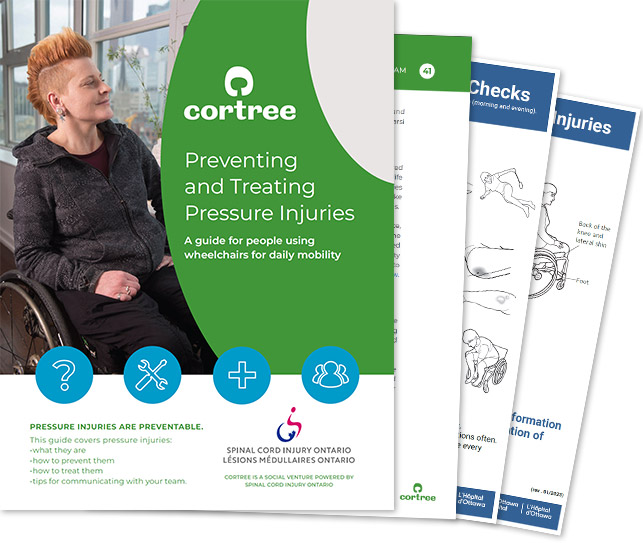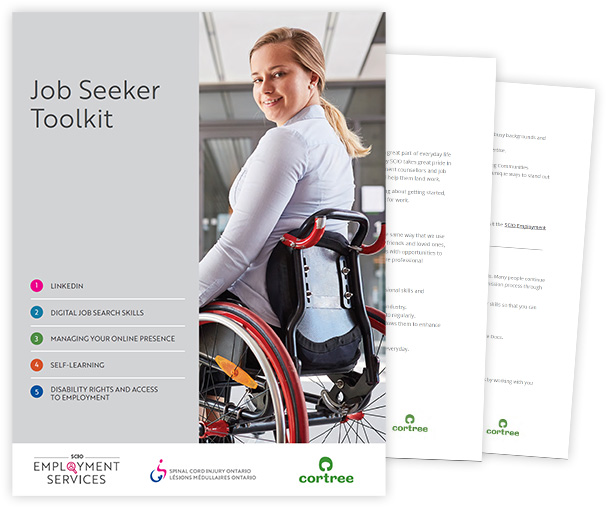Chronic Pain Management
Cortree Can Help You Understand the Meaning of Chronic Pain Management
On This Page We’ll Discuss:

Our years of experience working with people with spinal cord injuries and other mobility disabilities has given Cortree a specialized perspective on managing chronic pain.
If pain is affecting your life, you are not alone. Almost 20 per cent of Canadians live with chronic pain. Among people with neurological conditions the prevalence is closer to 40 per cent.
If you are experiencing chronic pain you know it can be hard to live with and difficult to treat. You may have questions like: Why am I in pain? Am I getting worse? When will it go away? What if it never goes away? Each flare up of pain can start a cycle of negative thoughts, symptoms and behaviours again. It can be really hard to feel optimistic about the future.
This page will help you learn about chronic pain management by discussing the meaning of chronic pain, the Canadian guidelines for chronic pain management, as well as some helpful techniques that have been found to significantly reduce pain in experimental and clinical settings.
Unfortunately it is not a quick fix. Like mastering any other skill, this will take time and persistence. The pain intensity or frequency may not necessarily decrease. But with practice your ability to cope with the pain will improve, and you will be able to focus more on what makes you feel good.
The Different Types of Pain
There are different kinds of pain and you may be experiencing some or all of them.
1
Musculoskeletal pain is usually dull or aching, and it mostly happens during certain movements and positions. Musculoskeletal pain is due to changes in bone, tendons or joints
2
Visceral pain comes from internal organs like the stomach or bladder. It can be hard to know where visceral pain is coming from. Usually it feels dull or tender, like cramping, and is caused by problems like constipation or bladder infections.
3
Neuropathic pain is often a burning, tingling, pins and needles, or electric shock feeling that can be felt anywhere in the body. Neuropathic pain can happen spontaneously, or be caused by things that don’t normally cause pain like the pressure of a child sitting on your lap. It can be felt far away from where the damaged nerve is, for example tingling in your fingers when the nerve problem is in your neck.
4
Acute pain is experienced right after an injury and is directly related to soft tissue damage. It arises quickly and can be severe but usually lasts a short period of time and is relatively straightforward to treat. Like Tylenol for a toothache, for example.

What is the Definition of Chronic Pain?
Before we can discuss chronic pain management, it’s important to understand the meaning of chronic pain.
The definition of chronic pain is pain that lasts for more than six months and it changes how pain is experienced in the nervous system.
Chronic pain may be related to medical conditions like multiple sclerosis or cancer, or it may be due to previous injury or arthritis. Chronic pain is more complex and challenging to treat and can get worse in response to environmental or psychological factors.
Unlike an objective experience which is tangible and can be experienced by others, pain is constructed by the individual mind. This means pain is a personal experience. The only way to measure pain is to ask you about it. This can add to the feeling of isolation for people living with pain. It can seem like no one understands what you’re dealing with.
Your psychological state modulates the perception of pain. This means pain can be turned up or down by other factors. Anxiety can make pain worse. Feeling calm or distracted can make pain better. This is because there are so many nerve connections involved in the experience of pain.
Anxiety and depression are common among people with chronic pain. Physical symptoms, unhelpful thoughts and unhelpful behaviours can all influence and trigger each other. Here’s an example of how that works:
- Physical symptom: Neck and shoulder pain.
- Unhelpful thought: I’m sure I won’t be able to sleep tonight.
- Unhelpful behaviour: I’ll have a few drinks to dull the pain.
Learning to manage emotional well-being by recognizing symptoms, and how they interact, is an essential part of chronic pain management.

What are Chronic Pain Management Guidelines?
Established in 2019, the Canadian Pain Task Force was designed to help address the needs of Canadians living with chronic pain. Their objective is to help create more effective strategies to better prevent, understand and manage chronic pain, while also exploring themes of societal inequity and new challenges being faced because of the Covid-19 pandemic.
Their chronic pain management guidelines involve both one-on-one session planning to create personal pain management plans, as well as leveraging external resources like group therapy, interactive workshops, educational modules and peer-led chronic pain management programs.
It also offers a variety of recommendations for subjects like improving the transitions between care facilities for people living with chronic pain, removing financial barriers to care and introducing training initiatives to allow for better interprofessional care.
Helpful Chronic Pain Management Programs
Because pain is complex, multidisciplinary treatment is often needed. Strategies like medications, physiotherapy, exercise, alternative medicine and surgery can be part of your plan. Your doctor may recommend that you enroll in a chronic pain management program. These are programs that are focused on rehabilitation for people with chronic pain.
Your health care team can work with you to discuss your treatment options. It may take a while and some trial and error to find what chronic pain management strategies work best. Having a support team that understands what you’re going through can make a huge difference. Knowing where to go for help when you need it is important. Your family doctor is a good place to start.
If you’d like to learn more about chronic pain relief, visit our page here.
Alternative Pain Management Techniques
Apart from pain medications, which are an important tool for helping patients keep their pain at manageable levels, there are a number of great alternative pain management techniques that can also be beneficial. One technique is learning to manage your attention.
Our attention can amplify our awareness of physical symptoms and their intensity when we focus on them. This can be a good thing in the case of acute pain: we should pay attention to the sudden onset of strong physical symptoms. With chronic pain, we may still experience strong physical symptoms, but paying attention to the symptoms doesn’t do anything to help the situation. In fact, the more we focus our attention on physical symptoms, the more unpleasant we find them.
By learning to manage attention we can consciously redirect our focus to something other than the physical symptoms and unhelpful thoughts connected to them. Over time many people find the symptoms improve, and so does what they are able to do in a day. The pain may still be there, but the experience may not be so unpleasant and disruptive.
Mindfulness is a non-judgmental awareness of the present moment experience. It often begins with focused attention on the sensations of breath or body. The aim is to gain stability of attention, so you can choose what to focus on, and what to say to yourself about it.
Among people with chronic pain mindfulness interventions have been shown to decrease anxiety, depression and distress, and to enhance quality of life. You can find more information on techniques for providing chronic pain relief here.

Pain Control Clinics & Additional Useful Resources
Also referred to as pain management clinics, pain control clinics are facilities that specialize in teaching you pain control techniques. Also, they can assist with your injections or medications, and help you create plans for managing your chronic pain.
Many of these clinics offer chronic pain management programs, as well as a number of other useful resources for people living with chronic pain. You can find an extensive list of the pain control clinics in Canada here.
If you’d like to learn more about pain clinics, visit our page here for more information.
You can also find some helpful learning plans and resources on living with chronic pain through Cortree. All you have to do is sign up, and you’ll be able to access all of our educational resources.
Cortree Can Assist with Your Chronic Pain Management
Dealing with chronic pain is never easy. It often takes a lot of time and effort to establish a chronic pain management strategy that will work for you.
The experts at Cortree have spent years working alongside people with disabilities, which gives us an informed perspective on chronic pain management. We’ve used that expertise to create the learning plans and training modules that you’ll find on our platform.
Regaining and maintaining the highest quality of life is the goal we strive to facilitate for people with disabilities, which is why our catalogue of resources are consistently growing in tandem with our own knowledge and experiences.
Sign up with Cortree today, and you’ll have all of our resources at your fingertips. Using these tools, we aim to help you expand your own knowledge to make life more inclusive and accessible for you and your loved ones.
Chronic pain management may not be easy, but you don’t have to do it alone. Cortree is here to help you learn to manage your pain, so you can start enjoying life again.

